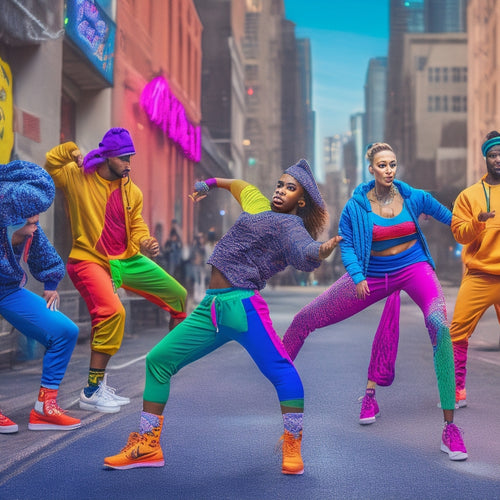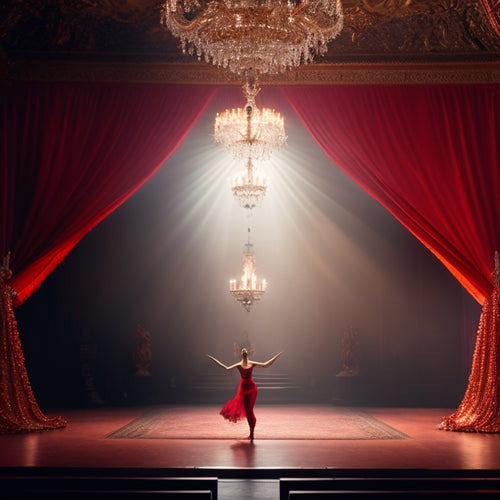
How Can I Improve My Roller Skating?
Share
You're already taking the first step towards improving your roller skating skills by acknowledging areas for growth. Focus on weight distribution, bent knees, and a low center of gravity to improve balance and stability. Engage your core, maintain a neutral spine, and reduce strain on your lower back to optimize posture and alignment. As you develop a smooth stride, don't forget to master crossover steps, focusing on balance and posture. With patience, persistence, and practice, you'll build confidence and mental preparation. Now, take your skills to the next level by exploring advanced techniques and tailored exercises tailored to your needs.
Key Takeaways
• Focus on weight distribution, knee bend, and core engagement to improve balance, stability, and posture.
• Practice shifting weight onto one foot and developing agility and reaction time to enhance overall skating ability.
• Master crossover steps, focus on balance and posture, and synchronize leg movements to develop a smooth stride.
• Incorporate visualization techniques, acknowledge skill development, and practice patience to build confidence and mental preparation.
• Set SMART goals, track progress, and find an accountability partner to stay motivated and improve your roller skating skills.
Mastering Balance and Stability
As you take your first strides on wheels, you'll quickly realize that mastering balance and stability is essential to progressing from a wobbly beginner to a confident roller skater. It's all about weight distribution and body awareness.
To improve your balance, focus on keeping your weight evenly distributed over both feet, with your knees bent and your center of gravity low. Practice shifting your weight onto one foot while keeping the other foot as an 'anchor' – this will help you develop the agility and reaction time you need to adjust to changing terrain.
As you become more comfortable, focus on maintaining good body awareness, keeping your head up, shoulders relaxed, and core engaged. With patience and practice, you'll be gliding effortlessly in no time!
Improving Posture and Alignment
As you work on improving your posture and alignment on roller skates, remember that engaging your core muscles is key to maintaining a strong, stable position.
You'll want to focus on activating your core by drawing your belly button towards your spine, which will help you maintain a neutral spine and reduce strain on your lower back.
Engage Core Muscles
By engaging your core muscles, you'll improve your posture and alignment on roller skates, allowing you to generate more power and stability with each stride.
Activating your core strength is essential, as it helps stabilize your body and maintain proper alignment. To engage your core, focus on muscle activation exercises off the skates, such as planks, crunches, and leg raises. This will help strengthen your core, allowing you to maintain good posture and alignment while skating.
As you skate, remember to engage your core by drawing your belly button towards your spine, keeping your pelvis in a neutral position. This will help you maintain balance, generate power, and improve your overall skating performance.
Maintain Neutral Spine
You can improve your posture and alignment on roller skates by maintaining a neutral spine, which helps to distribute your body weight evenly and maintain balance. This allows you to move freely and efficiently on the rink.
To achieve a neutral spine, focus on proper breathing techniques, feeling your breath expand your chest and engage your core muscles. Develop spinal awareness by imagining a string pulling your head up towards the ceiling, lengthening your spine.
As you glide on your skates, maintain this posture, keeping your shoulders relaxed and your weight evenly distributed on both feet. With practice, you'll develop muscle memory, and a neutral spine will become second nature, liberating you to focus on your skating techniques and enjoy the thrill of roller skating.
Developing a Smooth Stride
As you work on developing a smooth stride, you'll focus on mastering three key elements:
- crossover steps
- balance and posture
- an efficient knee bend
By refining these skills, you'll be able to glide effortlessly across the floor.
Mastering Crossover Steps
To master the crossover step, focus on synchronizing the movement of your legs, keeping your knees slightly bent and your weight evenly distributed between both feet. This will help you maintain edge control and generate power.
Practice footwork drills to develop muscle memory and confidence. Start with slow, small steps, gradually increasing your speed and stride as you become more comfortable.
Remember to keep your weight centered, with your knees bent to absorb any bumps or shocks. As you crossover, shift your weight onto the foot that's rolling onto the ground, using the other foot as a 'rudder' to steer and balance.
With consistent practice, you'll be gliding effortlessly in no time!
Balance and Posture
Your center of gravity plays an essential role in developing a smooth stride, as it directly affects your balance, agility, and overall skating efficiency. Maintaining good posture and balance is critical for fluid movements and control. To improve your balance, focus on body awareness by keeping your head up, shoulders relaxed, and weight evenly distributed on both skates. Confirm a proper Skate Fit, as ill-fitting skates can throw off your balance. Practice standing on one foot or doing single-leg squats to improve your overall balance.
| Tips for Balance and Posture | Benefits |
|---|---|
| Keep your head up and shoulders relaxed | Improved balance and posture |
| Maintain even weight distribution on both skates | Increased stability and control |
| Practice single-leg exercises off-skates | Enhanced balance and body awareness |
Efficient Knee Bend
You're now ready to build on your solid balance and posture foundation by incorporating an efficient knee bend. This will help you develop a smooth, powerful stride. To achieve this, focus on bending your knees slightly, keeping your weight evenly distributed on both feet.
Imagine performing a power squat, where you lower your body while keeping your back straight and your knees behind your toes. This will help you engage your quadriceps and hamstrings, generating power and speed.
Additionally, incorporate flexibility exercises into your routine, such as leg swings and lunges, to improve your range of motion.
As you master the efficient knee bend, you'll notice a significant improvement in your overall skating technique, allowing you to glide smoothly and effortlessly across the floor.
Building Confidence on Wheels
Standing on the threshold of your roller skating journey, it is important to acknowledge that building confidence on wheels is a skill that can be developed with practice, patience, and persistence. You've got this! Mental preparation is key. Visualization techniques can help you overcome fear and anxiety. Imagine yourself gliding effortlessly, turning with ease, and stopping with confidence.
| Fear | Freedom |
|---|---|
| Fear of falling | Embracing the thrill of the ride |
| Self-doubt | Believing in your abilities |
| Anxiety | Feeling empowered on wheels |
Enhancing Crossover Techniques
As you focus on enhancing your crossover techniques, you'll want to hone in on mastering inside edges, which will give you the stability and control you need to execute smooth changes.
By perfecting your inside edges, you'll be able to shift your weight seamlessly from one foot to the other, creating a fluid motion that's essential for advanced roller skating moves.
With practice, you'll be gliding effortlessly across the floor, your crossovers becoming second nature.
Mastering Inside Edges
Mastering inside edges requires precision and control. Focus on shifting your weight onto the inside edge of your skating foot as you prepare to execute a crossover, ensuring a seamless shift.
As you glide on the inside edge, maintain edge control by keeping your knee bent and your weight centered over the foot. This will allow you to maintain balance and stability.
Practice holding an inside glide on one foot, switching between feet to build muscle memory. Remember to keep your shoulders relaxed and your core engaged, allowing you to move freely and smoothly.
With consistent practice, you'll develop the edge control and confidence to take your crossovers to the next level.
Executing Smooth Transitions
You'll take your crossovers to the next level by focusing on executing seamless changes, which require precise timing and fluid movements to maintain speed and control.
To achieve this, work on your edge control by practicing subtle weight transfers and shifts in pressure. Rhythm drills can help you develop a sense of timing and coordination. Try skating in a circle, focusing on smooth transformations between edges.
As you gain confidence, increase your speed and add in crossovers. Remember to keep your knees bent and weight centered, allowing you to make quick adjustments as needed.
With practice, your transformations will become second nature, and you'll be gliding effortlessly across the floor.
Mastering Stopping and Braking
When you're gliding on wheels, being able to stop confidently and safely is crucial, so it's important to develop a reliable braking technique that becomes second nature. Mastering stopping and braking is essential for freedom and confidence on the rink.
Here are some key techniques to focus on:
-
Heel brakes: Practice digging one edge of your skate into the floor, using your heel as a brake.
-
Toe stops: Learn to use your toe stops effectively, applying gentle to firm pressure depending on your speed.
-
Knee bending: Bend your knees to lower your center of gravity, making it easier to stop and control your movements.
- Weight distribution: Shift your weight onto your braking foot, using your body weight to help bring you to a smooth stop.
Increasing Speed and Agility
As you build momentum and confidence on the rink, increasing your speed and agility becomes a natural next step, and with a few key techniques, you can access a more dynamic and exhilarating skating experience.
To boost your speed, focus on generating power bursts by explosively pushing off with one foot while bringing the other foot to meet it. This will help you quickly accelerate and maintain speed.
Practice quick accelerations by shifting your weight onto one foot and then the other, creating a rapid-fire motion that propels you forward.
As you master these techniques, you'll find yourself gliding across the rink with ease and precision, feeling a sense of freedom and empowerment with every stride.
Practicing Turns and Corners
Mastering turns and corners is an essential aspect of roller skating, and it starts with developing a solid understanding of edge control and body positioning. To improve your turns, focus on shifting your weight, bending your knees, and using your edges to carve through corners.
Trail blazing requires precision and control, and with practice, you'll be gliding through turns like a pro!
Here are some cornering drills to help you improve:
-
Slow and steady: Practice slow, tight turns to develop edge control and balance.
-
Wide and loose: Skate wide, sweeping turns to work on your body positioning and flow.
-
Cone drills: Weave through cones or small obstacles to improve your agility and reaction time.
- Fast and furious: Skate fast, aggressive turns to build confidence and speed.
Overcoming Fear and Anxiety
Fear and anxiety can be major obstacles to improving your roller skating skills, but by acknowledging and addressing these emotions, you'll be able to overcome them and unlock your full potential on wheels.
It's crucial to recognize that fear is normal, and it's okay to feel intimidated. To overcome your fears, try incorporating mindfulness exercises into your routine, such as deep breathing and visualization.
Gradual exposure to the feared situations or skills can also help you build confidence. For example, if you're afraid of falling, start by practicing small falls in a controlled environment.
Fear exposure, when done gradually and safely, can help you become more comfortable and confident on your skates.
Setting Realistic Goals and Tracking Progress
You'll be more motivated to improve your roller skating skills if you set specific, achievable goals and track your progress, giving you a sense of accomplishment and direction. This mindset shift will help you stay focused and driven.
To get started, follow these steps:
-
Set SMART goals: Break down large goals into smaller, manageable tasks to maintain consistency and track progress.
-
Find an accountability partner: Share your goals with a friend or mentor to increase motivation and receive support.
-
Create a reward system: Treat yourself to something fun after reaching milestones to stay motivated.
- Keep a progress journal: Record your progress, note areas for improvement, and celebrate successes.
Frequently Asked Questions
What Are the Best Roller Skating Exercises for Strengthening Ankles?
"You'll boost ankle strength with exercises targeting ankle mobility and foot stability. Try single-leg balancing, ankle circles, and toe raises to enhance your overall roller skating performance and gain the freedom to glide with confidence."
Can I Learn to Roller Skate if I'm Extremely Clumsy?
You can absolutely learn to roller skate even if you're extremely clumsy! Don't let fearful falls hold you back - focus on building confidence, and with practice, your skills will shine, leaving clumsiness in the dust!
How Often Should I Practice to See Significant Improvement?
To see significant improvement, you'll want to create a consistent skate schedule, aiming for 2-3 times a week, and track your progress by noting what you've mastered and what still needs work, adjusting your routine accordingly.
What's the Best Way to Protect My Knees While Roller Skating?
"Ha! You think you're too cool for knee guards? Newsflash: even pros wear them! Invest in sturdy knee guards and safety pads, and you'll be carving up the rink with confidence, not crying over scraped knees."
Can I Customize My Roller Skates to Fit My Foot Shape?
'Customizing your roller skates to fit your unique foot shape is a game-changer! You can explore footbed options and adjust the skate width to guarantee a snug, comfortable fit, giving you the freedom to glide with confidence.'
Related Posts
-

10 Essential Tips for Dance Makeup Entrepreneurs
As a dance makeup entrepreneur, you're ready to take your unique style to the next level. Define your brand's Unique ...
-

Hip Hop Dance Apparel for Style and Function
Hip hop dance apparel combines style and functionality, so you can move with confidence and flair. Look for breathabl...
-

Dance Spectacular With Limited Seating Offer
Experience the magic of dance with Santa Barbara Festival Ballet's 'Growing Up With Dance' spectacular, featuring bre...


